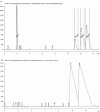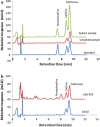Preparative HPLC for large scale isolation, and salting-out assisted liquid-liquid extraction based method for HPLC-DAD determination of khat (Catha edulis Forsk) alkaloids
- PMID: 29086876
- PMCID: PMC5645267
- DOI: 10.1186/s13065-017-0337-6
Preparative HPLC for large scale isolation, and salting-out assisted liquid-liquid extraction based method for HPLC-DAD determination of khat (Catha edulis Forsk) alkaloids
Abstract
Background: Khat (Catha edulis Forsk) is an evergreen shrub of the Celastraceae family. It is widely cultivated in Yemen and East Africa, where its fresh leaves are habitually chewed for their momentary pleasures and stimulation as amphetamine-like effects. The main psychostimulant constituents of khat are the phenylpropylamino alkaloids: cathinone, cathine and norephedrine.
Results: In this study, simple procedures based on preparative HPLC and salting-out assisted liquid-liquid extraction (SALLE) based methods were developed respectively for large scale isolation and the extraction of psychoactive phenylpropylamino alkaloids; cathinone, cathine and norephedrine, from khat (Catha edulis Forsk) chewing leaves, a stimulant and drug of abuse plant. The three khat alkaloids were directly isolated from the crude oxalate salt by preparative HPLC-DAD method with purity > 98%. In addition, a modified (SALLE) method has been developed and evaluated for the extraction efficiency of psychoactive phenylpropylamino alkaloids from khat (Catha edulis Forsk) chewing leaves. An in situ two steps extraction protocol was followed without dispersive SPE clean up. The method involves extraction of the samples with 1% HAc and QuEChERS salt (1.0 g of CH3COONa and 6.0 g of MgSO4) followed by subsequent in situ liquid-liquid partitioning by adding ethyl acetate and NaOH solution. The optimized method allowed recoveries of 80-86% for the three alkaloids from khat sample with relative standard deviation (RSD) values less than 15% and limits of detection (0.85-1.9 μg/mL).
Conclusion: The method was found to be simple, cost-effective and provides cleaner chromatogram with good selectivity and reproducibility. The SALLE based protocol provided as good results as the conventional extraction method (ultrasonic assisted extraction followed by solid phase extraction, UAE-SPE) and hence the method can be applicable in forensic and biomedical sectors.
Keywords: Alkaloids; Cathine; Cathinone; Khat; Norephedrine; Preparative HPLC; Salting-out assisted liquid–liquid extraction.
Figures





Similar articles
-
Developmental patterns of phenylpropylamino alkaloids accumulation in khat (Catha edulis, Forsk.).J Ethnopharmacol. 2007 Dec 3;114(3):432-8. doi: 10.1016/j.jep.2007.08.042. Epub 2007 Sep 1. J Ethnopharmacol. 2007. PMID: 17928181
-
A (-)-norephedrine-based molecularly imprinted polymer for the solid-phase extraction of psychoactive phenylpropylamino alkaloids from Khat (Catha edulis Vahl. Endl.) chewing leaves.Biomed Chromatogr. 2016 Jul;30(7):1007-1015. doi: 10.1002/bmc.3643. Epub 2015 Dec 1. Biomed Chromatogr. 2016. PMID: 26531856
-
Isolation and in vitro permeation of phenylpropylamino alkaloids from Khat (Catha edulis) across oral and intestinal mucosal tissues.J Ethnopharmacol. 2016 Dec 24;194:307-315. doi: 10.1016/j.jep.2016.09.012. Epub 2016 Sep 9. J Ethnopharmacol. 2016. PMID: 27616032
-
Khat (Catha edulis Forsk) - And now there are three.Brain Res Bull. 2019 Feb;145:92-96. doi: 10.1016/j.brainresbull.2018.07.014. Epub 2018 Jul 27. Brain Res Bull. 2019. PMID: 30059706 Review.
-
"Natural Amphetamine" Khat: A Cultural Tradition or a Drug of Abuse?Int Rev Neurobiol. 2015;120:235-55. doi: 10.1016/bs.irn.2015.02.006. Epub 2015 Mar 9. Int Rev Neurobiol. 2015. PMID: 26070760 Review.
Cited by
-
Salting-out assisted liquid-liquid extraction for the determination of ciprofloxacin residues in water samples by high performance liquid chromatography-diode array detector.BMC Chem. 2019 Mar 9;13(1):28. doi: 10.1186/s13065-019-0543-5. eCollection 2019 Dec. BMC Chem. 2019. PMID: 31384776 Free PMC article.
-
Nanoencapsulation of apocynin and vanillic acid extracted from Picrorhiza kurroa Royle ex Benth plant roots and its characterisation.Heliyon. 2024 Feb 14;10(4):e26156. doi: 10.1016/j.heliyon.2024.e26156. eCollection 2024 Feb 29. Heliyon. 2024. Retraction in: Heliyon. 2025 Feb 18;11(4):142676. doi: 10.1016/j.heliyon.2025.142676. PMID: 38390167 Free PMC article. Retracted.
-
Interpol review of controlled substances 2016-2019.Forensic Sci Int Synerg. 2020 May 24;2:608-669. doi: 10.1016/j.fsisyn.2020.01.019. eCollection 2020. Forensic Sci Int Synerg. 2020. PMID: 33385148 Free PMC article. Review.
-
Rapid and simultaneous determination of trigonelline, caffeine, and chlorogenic acid in green coffee bean extract.Food Sci Nutr. 2021 Jul 5;9(9):5028-5035. doi: 10.1002/fsn3.2456. eCollection 2021 Sep. Food Sci Nutr. 2021. PMID: 34532014 Free PMC article.
References
LinkOut - more resources
Full Text Sources
Other Literature Sources

